Santa Cruz’s 2022 Bronson transitions to a 29in front wheel and 27.5in rear wheel ‘mullet setup’ from the 27.5in front and rear design of the old bike, but still hopes to retain the same do-it-all characteristics that make it one of the brand’s most popular models.
Santa Cruz says “if in doubt, take a Bronson out,” suggesting the 150mm travel rig should be capable of tackling any type of riding from enduro riding and jump sessions to singletrack epics.
- Further reading: What’s faster, a 29er or mullet bike setup?
2022 Santa Cruz Bronson CC MX frame and suspension details

The newest Bronson’s outline mimics the rest of the brand’s full-sus bikes (except the XC-focused Blur), where the shock is mounted low down in the frame and driven by the bottom VPP linkage.
Despite the similar looks, the latest Bronson’s frame has received updates over the old model and, beyond the obvious change to mullet wheels, it has a much chunkier down tube with a sharper angle where the rear shock mounts to it, and there’s space for coil or air shocks with high volume air chambers.
Additionally, the underside of the down tube has built-in rock strike protection, and a second protective area is designed to stop the down tube from getting damaged when the bike is transported on a pickup truck tailgate.
It features chainstay and seatstay chain slap protection and internally routed cables with internal tubing to make routing easier.
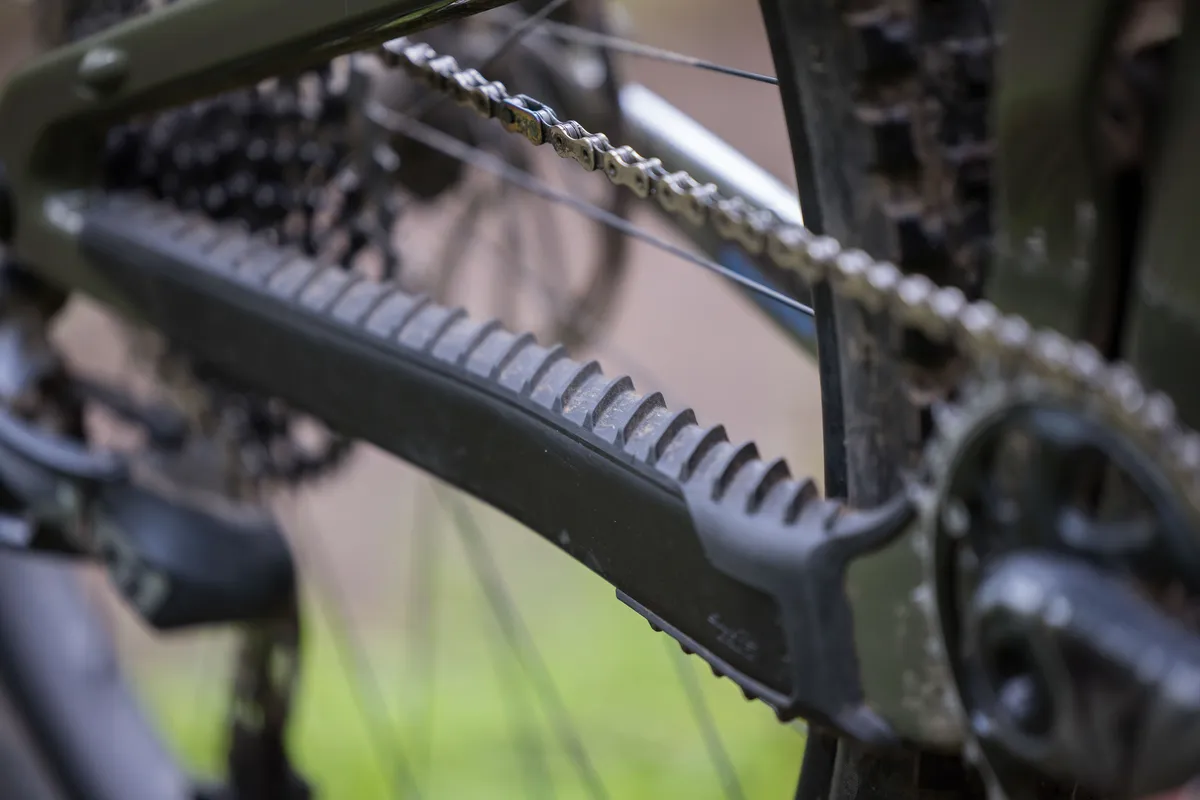
There’s a water bottle mount on the top side of the down tube, with plenty of space for a full-size 750ml bottle on my size large test bike.
It has a threaded BSA 73mm bottom bracket, a 31.6mm seatpost and ISCG05 chain guide tabs. The rear axle is a Boost 148×12 but it only has space for 2.6in rear tyres, foregoing the previous model’s ability to run true plus-size 27.5in rubber.
This model’s frame is built using Santa Cruz’s most expensive CC carbon fibre, which the brand claims is lighter but retains the same strength as the C level material. The frame and bearings are offered with a lifetime guarantee.
The metric-sized rear shock (230×60mm) is mounted to the front triangle using 30×8mm hardware and a standard bushing, and while the linkage mount end uses the same width hardware, it’s installed with a bearing instead of a bushing because the mount rotates as the shock compresses.
This should help increase the lifespan of the mount and potentially reduce any bushing-induced friction.
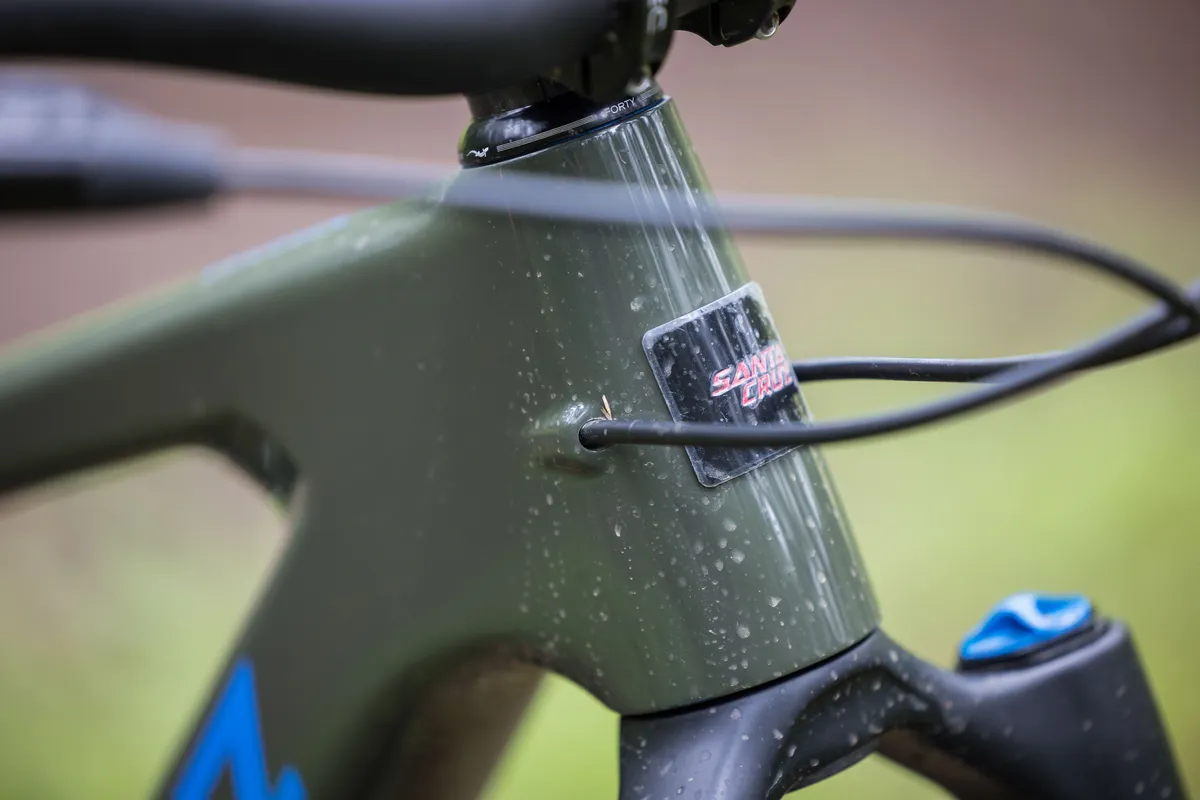
The 150mm travel VPP suspension has been tuned to provide lower amounts of anti-squat and less pedal feedback than the outgoing model. To achieve this, the VPP pivot’s instant centre (the location of the virtual pivot as the bike cycles through its travel) is lower than the old model through its travel.
It also has a slightly lower leverage rate than the outgoing bike but is more progressive overall. Using the graphs supplied by Santa Cruz, I calculated the 2022 Bronson to be 26.66 per cent progressive, while the older bike was 20.79 per cent. These changes are also linked to the increase in shock size on the newest bike.
On the trail, this should mean the suspension is more supple and easier to move at the start of its stroke while it ramps up more towards the end of its travel, providing bottom-out resistance.
2022 Santa Cruz Bronson CC MX geometry
The Bronson’s middle-of-the-road 150mm travel is mirrored in its geometry.
However, this iteration of the bike does get some significant updates that see its reach, chainstay and wheelbase figures grow, while head tube angles slacken and seat tube angles steepen.

Along with a high and low position flip-chip on the rearward shock mount, which adjusts head angles from 64.5 degrees to 64.7 degrees and bottom bracket heights from 341mm to 344mm, there are also size-specific chainstays that incrementally grow as the bike’s size does.
The change in length is taken care of with changes in linkage and pivot placement, not the swingarm. This means it’s not possible to swap swingarms between sizes and increase chainstay lengths.
| Size | Extra-small (low/high) | Small (low/high) | Medium (low/high) | Large (low/high) | Extra-large (low/high) |
|---|---|---|---|---|---|
| Reach (mm) | 402/405 | 427/430 | 452/455 | 472/475 | 497/500 |
| Stack (mm) | 595/594 | 619/617 | 628/626 | 637/635 | 651/649 |
| Head tube angle (degrees) | 64.5/64.7 | 64.5/64.7 | 64.5/64.7 | 64.5/64.7 | 64.5/64.7 |
| Seat tube length (mm) | 370 | 380 | 405 | 430 | 460 |
| Front centre (mm) | 722 | 757 | 786 | 810/811 | 842 |
| BB height (mm) | 341/344 | 341/344 | 341/344 | 341/344 | 341/344 |
| Wheelbase (mm) | 1154/1149 | 1189/1188 | 1222/1221 | 1249 | 1285/1284 |
| Chainstay length (mm) | 432/427 | 432/431 | 436/435 | 439/438 | 443/442 |
| Head tube length (mm) | 110 | 100 | 110 | 120 | 135 |
| Top tube length (mm) | 542/536 | 575/570 | 604/599 | 627/623 | 675/653 |
| Seat tube angle (degrees) | 76.9/77.6 | 76.7/77.2 | 76.6/77.1 | 76.5/76.9 | 76.4/76.7 |
| Standover (mm) | 698/701 | 706/709 | 727/731 | 726/729 | 725/728 |
In the low setting – where the bike stayed for most of the test period – the size large I tested has a reasonable 472mm reach, a fairly slack 64.5-degree head tube angle and a relatively long 1,249mm wheelbase and quite short 439mm chainstays. There’s a 76.5-degree effective seat tube angle, which looks good on paper.
Because of the Bronson’s intended diversity, it’s clear to see how Santa Cruz has ended up with geometry figures that aren’t too extreme in one direction or another.
2022 Santa Cruz Bronson CC MX X01 AXS RSV specifications
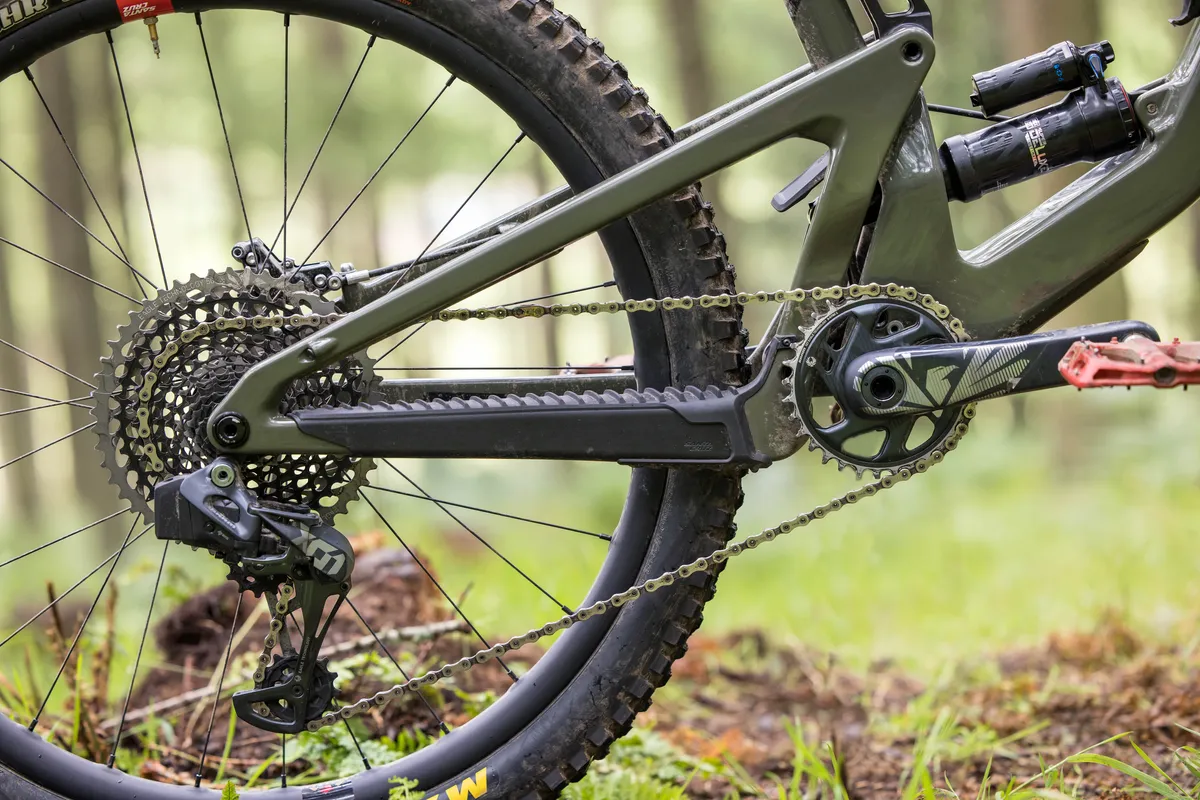
The Bronson CC X01 AXS RSV sits one down from the top of the range bike, and its £8,599 / $9,849 price tag is testimony to that.
As the lengthy model name suggests, this Bronson gets the top-spec carbon fibre frame, SRAM’s X01 Eagle AXS drivetrain (but with a GX Eagle AXS shifter) and Santa Cruz’s Reserve carbon fibre wheelset.
In more detail, then, the X01 Eagle AXS drivetrain is specced with SRAM’s smaller 10-50t cassette rather than the bigger 52t option and comes with the GX Eagle AXS shifter that although mechanically (and electronically) speaking is identical to the X01 version, it has a different finish.
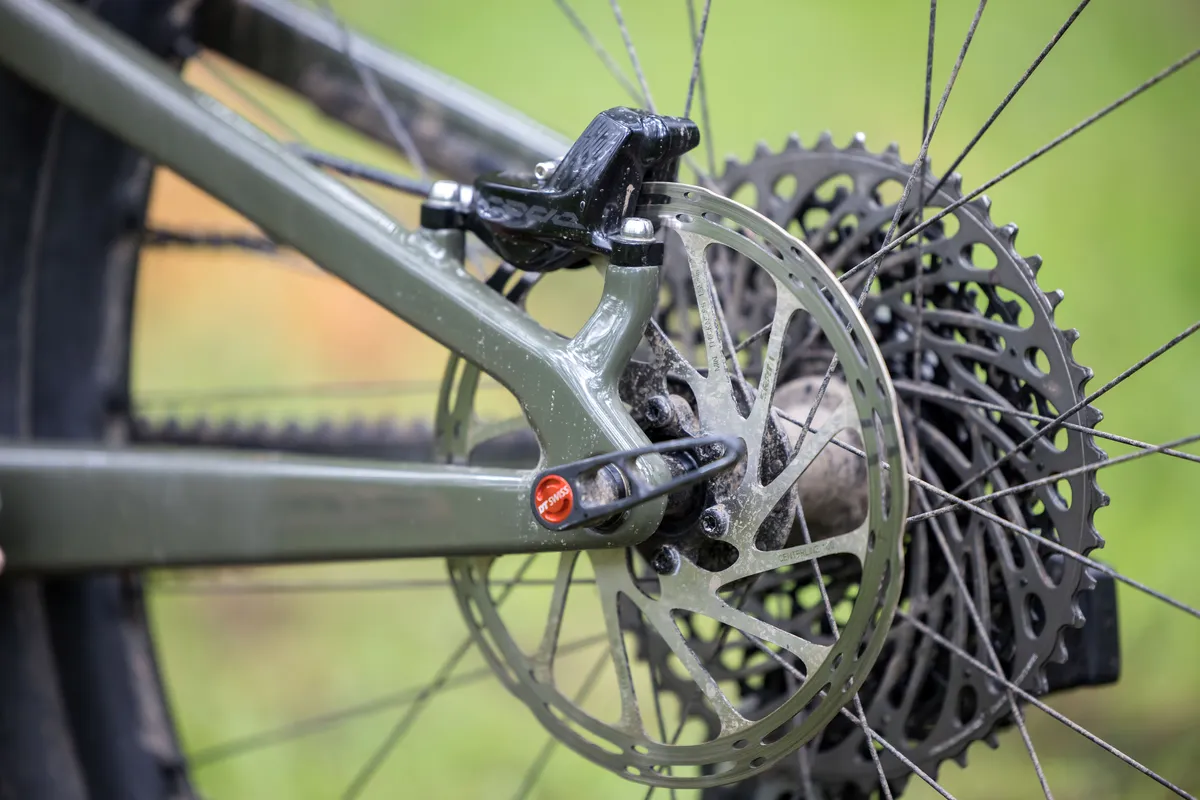
Elsewhere from the SRAM/RockShox stable are Code RSC brakes with a 200mm front rotor and 180mm rear, and a Reverb dropper post with 1x lever.
Finally, there’s a RockShox Super Deluxe Ultimate rear shock with low-speed compression, rebound adjustment and a lockout lever.
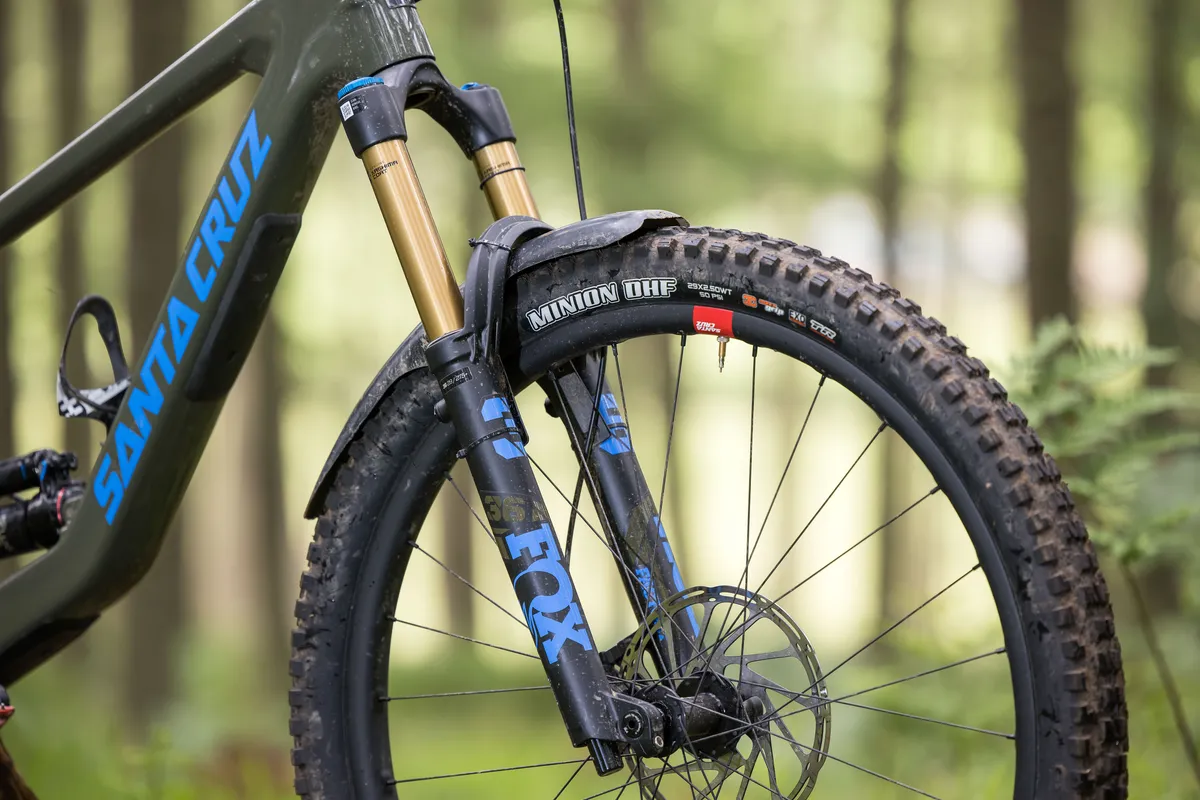
That shock is mated to Fox’s 36 Factory fork which is fitted with the GRIP2 damper with both high- and low-speed compression and rebound adjustment and 160mm of travel.
The Santa Cruz Reserve 30 V2 carbon fibre wheels are laced to Industry Nine 1/1 hubs both front and rear. These rims are wrapped in Maxxis Minion DHF 3C MaxxGrip EXO TR 2.5×29in front and Maxxis Minion DHR II 3C MaxxGrip EXO TR 2.4×27.5in rear.
There’s a Santa Cruz 35 Carbon Bar and a Burgtec MK3 Enduro stem that’s 42.5mm long, Santa Cruz House Grips and a WTB Volt saddle.
My Santa Cruz Bronson CC X01 AXS RSV test bike in a size large without pedals weighed 14.15kg.
2022 Santa Cruz Bronson CC MX X01 AXS RSV ride impressions
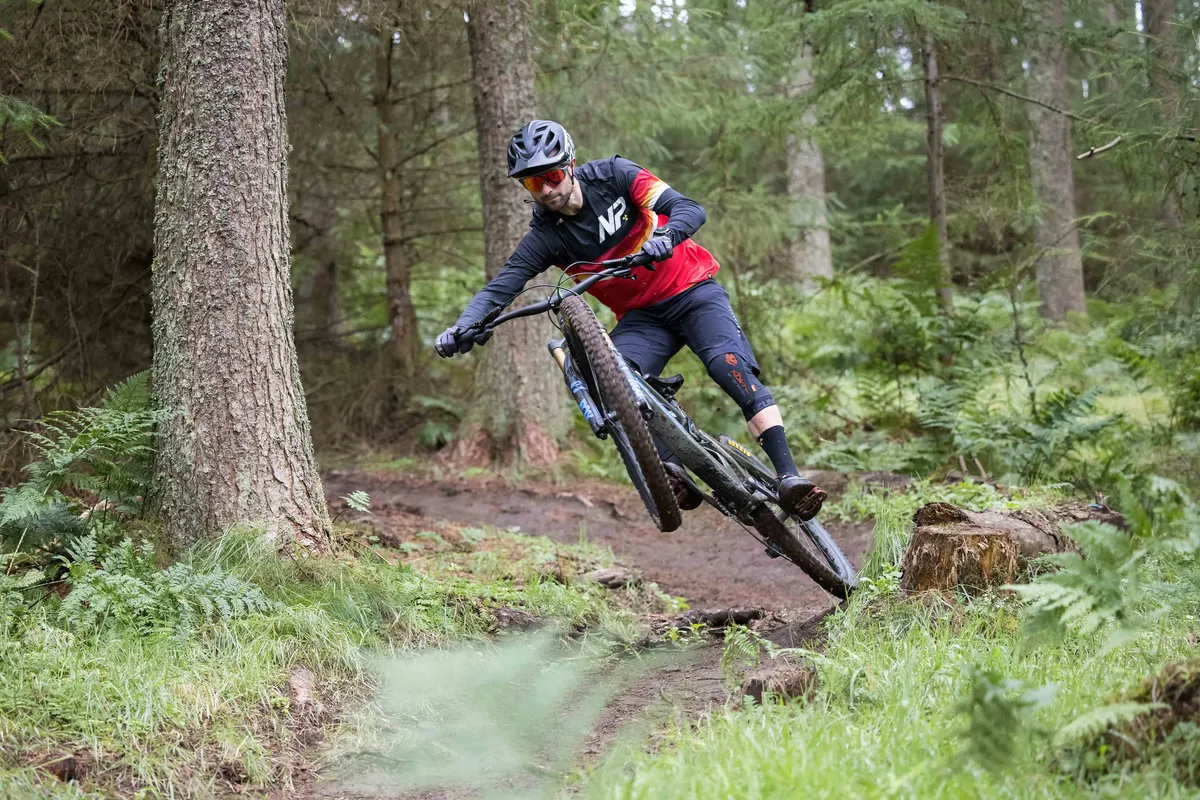
I tested the Bronson on my home trails in Scotland’s Tweed Valley, home to the UK’s round of the Enduro World Series and award-winning Glentress trail centre.
That meant I got to ride the Bronson on a host of trails, ranging from incredibly steep on-the-brakes enduro runs and flat-out DH tracks to pedal-focused graded trail centres, to see just how much of a generalist the bike is. Conditions ranged from deep summertime dust to early autumn slop.
2022 Santa Cruz Bronson CC X01 AXS RSV setup
For my 178cm height, I opted for the size large Bronson, with its 472mm reach figure and 627mm top tube – close to perfect for my size and preferences.
However, size large bikes are slowly getting bigger, and the Bronson’s reach figure is on the shorter side when compared to some other brands, such as Pole’s Stamina 160 Remastered and Marin’s Alpine Trail.
Weighing 77kg kitted up, I initially set the Fox 36 forks to 85psi, but had to install two extra tokens after persistently bottoming out, taking the total count to three, and increased air pressure to 93psi. This set the fork with 20 per cent sag.
I set the high- and low-speed rebound and compression damping adjustments to fully open, which was just quick enough for my preferences.
I inflated the rear shock to 172psi and kept the two stock tokens installed, giving 15mm or 26 per cent sag. This was marginally less than the recommended settings on Santa Cruz’s website, where it states someone my weight should run around 16.5 to 19mm of sag.

I ended up with these pressures after much experimentation with more and less air, finding the setup offered the best compromise between smoothness, mid-stroke support and bottom-out resistance without causing the bike to squat too low at the rear, exaggerating the high feeling front end – but more on that shortly.
Like the fork, I had to wind all the external rebound and compression shock adjustments to fully open to make it feel how I wanted it.
I inflated the EXO casing tyres to 24psi front and 27.5psi rear but ended up increasing the tyre pressure in the rear to 29psi, especially when it was dry, to counter carcass roll and squirm and limit the potential for pinch flats.
Flip-chip geometry change difficulties
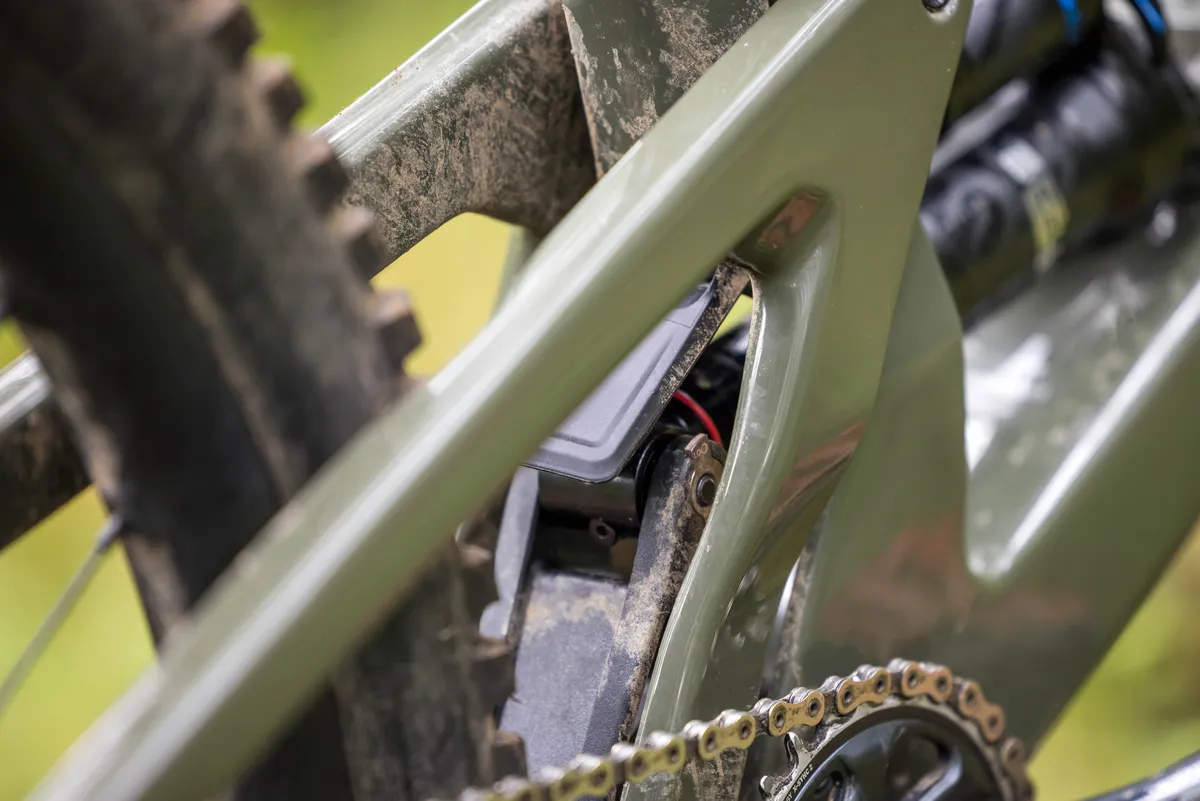
Although Santa Cruz has added a tab to the rear shock’s driveside flip-chip shock bolt to make installation and geometry changes easier and quicker to perform, I found the process quite tricky and not one that could be easily done trail-side.
It was very easy to lose the captive shock nut and geometry flip-chip into the bike’s linkage and behind the chainring during installation or removal. The shock’s eyelet bearings were also easy to displace as the shock was pushed into its position, causing further installation headaches.
I found it best to use a pair of snipe nose pliers to hold the flip-chip’s tab in place, then carefully move the shock into position without losing any of the bushings and, finally, slide the bolt through from the non-driveside. Clearly, the small tabs aren’t a significant improvement over the old model’s mounts.
Arguably the irregularity of geometry adjustment meant installation issues were a minor frustration at worse because once I had tried the high setting – and couldn’t discern any advantages for the style of riding I do most – I returned the bike to its low position for the duration of the test, and suspect prospective owners will do the same.
2022 Santa Cruz Bronson CC MX X01 AXS RSV climbing performance

The Bronson certainly felt nippy when cranking on the pedals, whether that was standing up or seated, and there were very limited amounts of pedal bob, despite Santa Cruz’s claims it has reduced anti-squat (the bike’s innate ability to resist suspension compression caused by pedal bob).
- Further reading: The ultimate guide to mountain bike rear suspension systems
The Bronson had a lot of get up and go with little power lost to unwanted movement, especially given the 150mm of travel on tap, and this build’s low weight and EXO-casing tyres contributed to its snappy-feeling on-the-cranks prowess.
This meant it was thoroughly enjoyable to sprint on short, sharp uphill sections without feeling like precious energy was getting sapped away by the bike. I found standing up pedalling was the best way to get the most forward momentum from the Bronson, where burying yourself on a climb wasn’t the slow-going affair of some enduro bikes with a similar travel figure.
Of course, it’s not totally without pedal bob, and when sat down at high cadences the rear end did dip in and out of its sag point. The climb lever eliminated this movement but also sacrificed comfort and traction, especially when the climbs became bumpy or their surfaces loose.
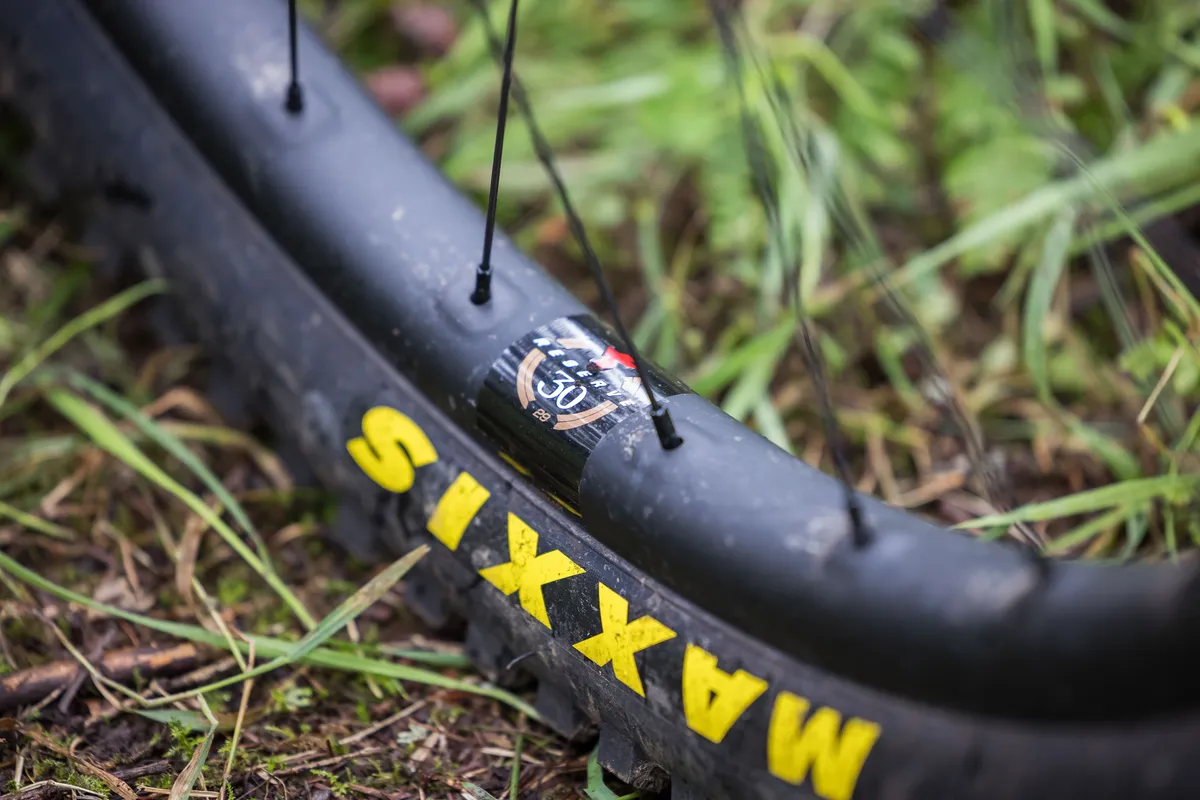
This meant the climb lever was best suited to being used on long tarmac drags rather than off-road. Because of this, I left the bike in the open position for the duration of the test period without feeling like I was losing energy – the Bronson is an efficient pedaller.
A comfortable riding position
The seated riding position was generally comfortable, not forcing me into an overly hunched forward position. My weight wasn’t too concentrated through my hands, improving comfort on longer ascents further. However, neither was I too upright and unable to aggressively lower my body without the bike feeling far too short.
This well-balanced feel meant the Bronson was at home spinning around trail centre loops, on long fire road climbs and less steep technical off-piste ascents.
However, the seat tube angle did feel too slack at times, especially when the gradient increased. I found I had to shift the saddle as far forward on its rails as I could, and angle its nose down in the seat clamp to help shift my hips further forwards over the bottom bracket for improved comfort.
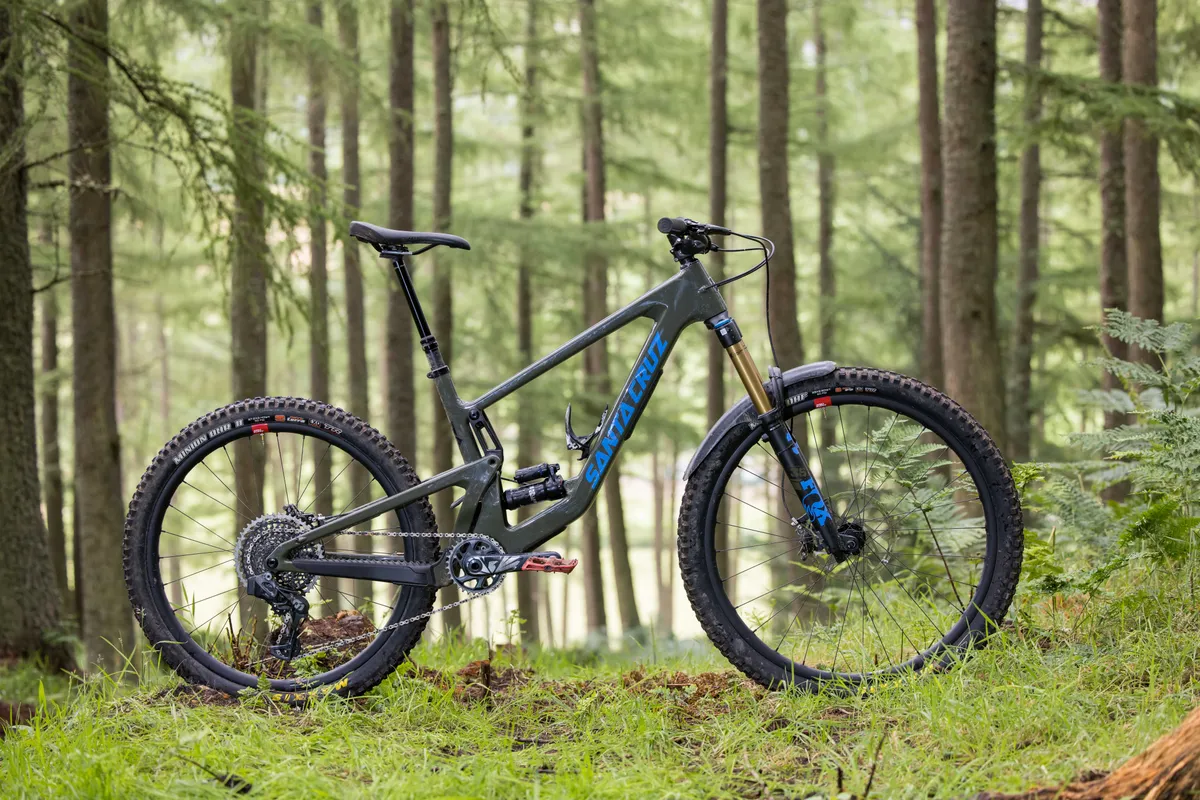
On steeper climbs, I was also shifting my body’s weight onto the saddle’s nose to control the amount of weight on the front wheel. This stopped it from lifting and better centralised my body over the bike, but sapped energy and required concentration.
This proved to be tiring and was most noticeable when riding the Bronson back-to-back with Pole’s Stamina 160 Remastered, with a 78-degree seat tube angle.
But, given the generalist nature of the Bronson, the seat tube angle wasn’t too slack for most climbing scenarios. However, in my opinion, being a degree or two steeper would improve every riding scenario.
Supportive and firm
The suspension wasn’t super-supple and didn’t feel fluttery over the minutiae of trail chatter, at times almost struggling to break into its initial stroke.
This could be down to several factors, including the way Super Deluxe Ultimate rear shocks feel at the start of their travel, requiring a little more force to compress than other offerings.
Although I was unable to verify this with testing, I suspect a coil shock – especially a super-supple one like Fox’s DHX2 – would improve the Bronson’s off-the-top suspension compliance.
Even though it had an initial resistance, it still did a reasonable job of ironing out the sting from most smaller bumps, a feeling certainly helped by the soft compound MaxxGrip and MaxxTerra tyres.
And despite the suspension not feeling the smoothest, it was active enough to let the bike hold speed on rough sections with small to medium-sized hits where pedalling wasn’t possible.
The rear end had plenty of mid-stroke support and bottom-out resistance.
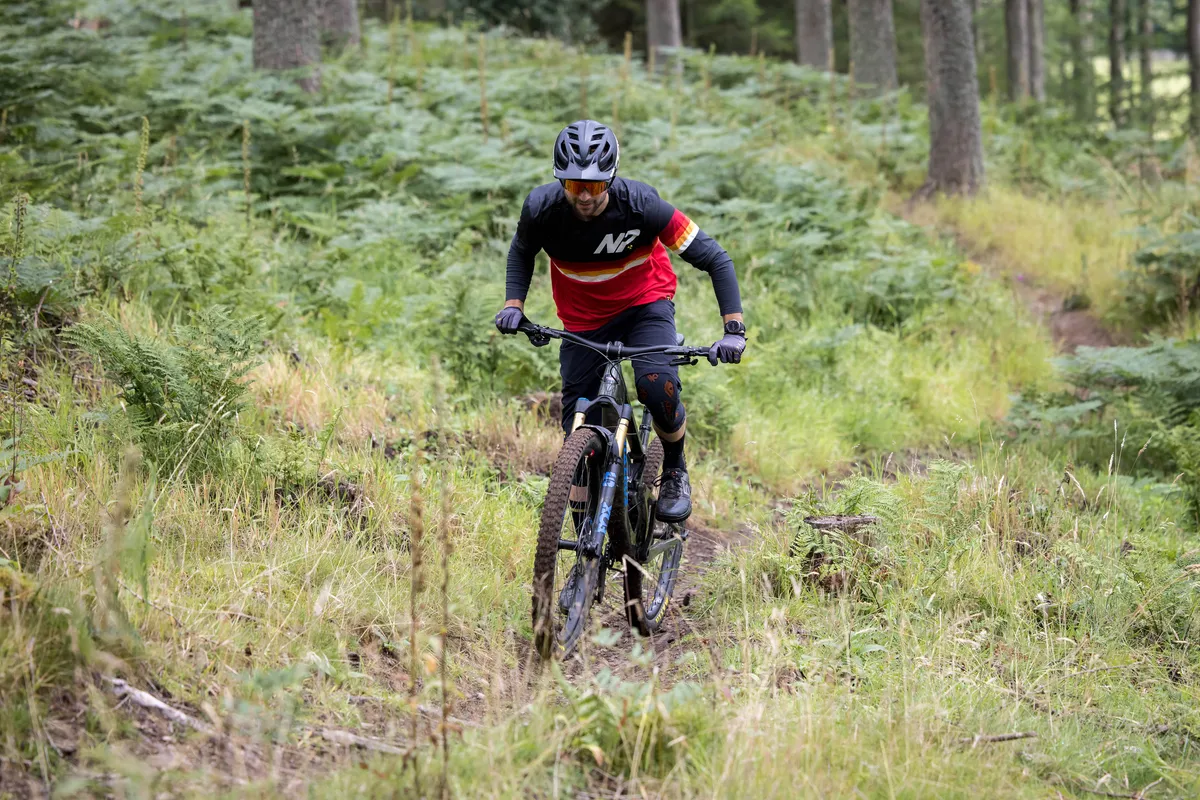
This meant I could plough through medium to large-sized compressions without needing to brace for harsh bottom-outs or shift my weight around to keep the bike controlled.
This reduced the amount of energy required to ride and made it easier to focus on making progress rather than worrying about blowing through the travel.
Arguably, I would take this type of performance over a fluttery rear end.
Some spec compromises
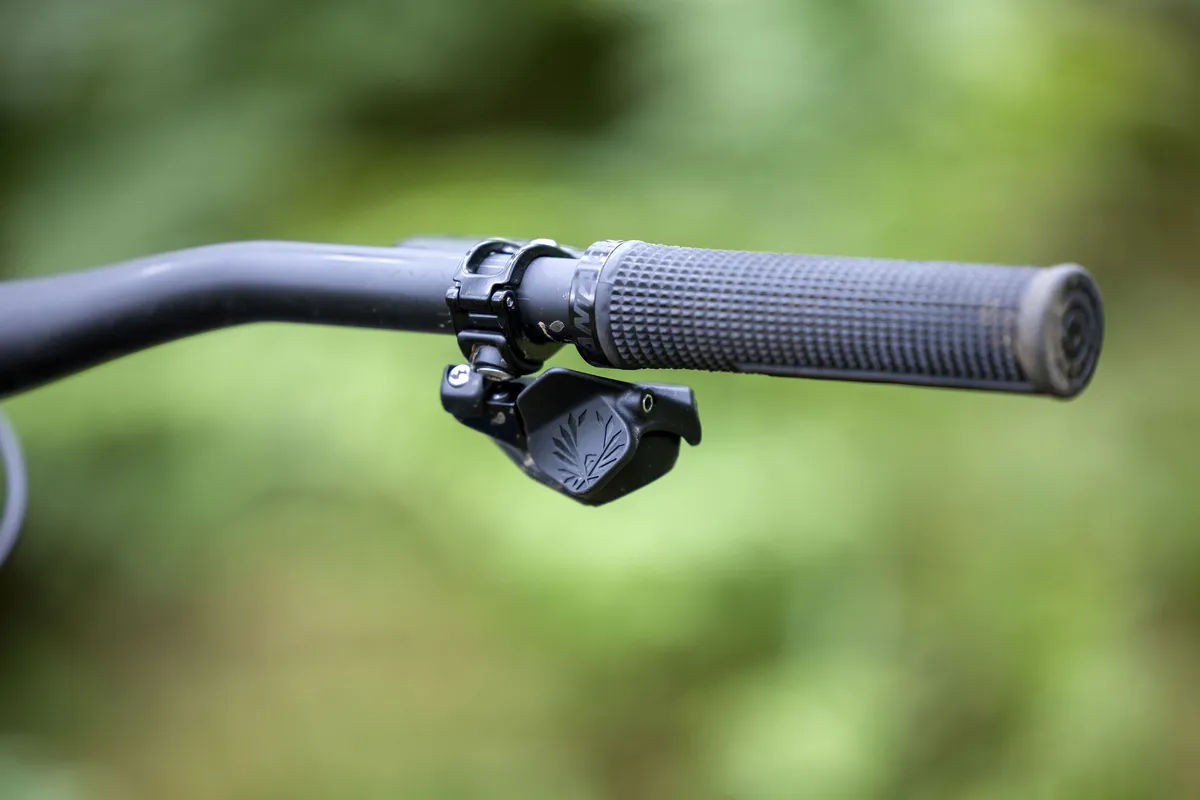
SRAM’s X01 Eagle AXS derailleur, XG1295 cassette and X01 Eagle chain are paired with the lower cost GX Eagle AXS shifter/controller in a bid to save some money, but it’s a shame there isn’t a full house of X01 kit given the asking price – despite the GX shifter not performing any differently to the X01 Eagle AXS and XX1 Eagle AXS versions.
However, the GX Eagle AXS controller makes the hydraulic Reverb’s lever feel truly archaic both in terms of how much travel there is and how hard it is to push. Although this is only compared to the light, disconnected action of an AXS Reverb.
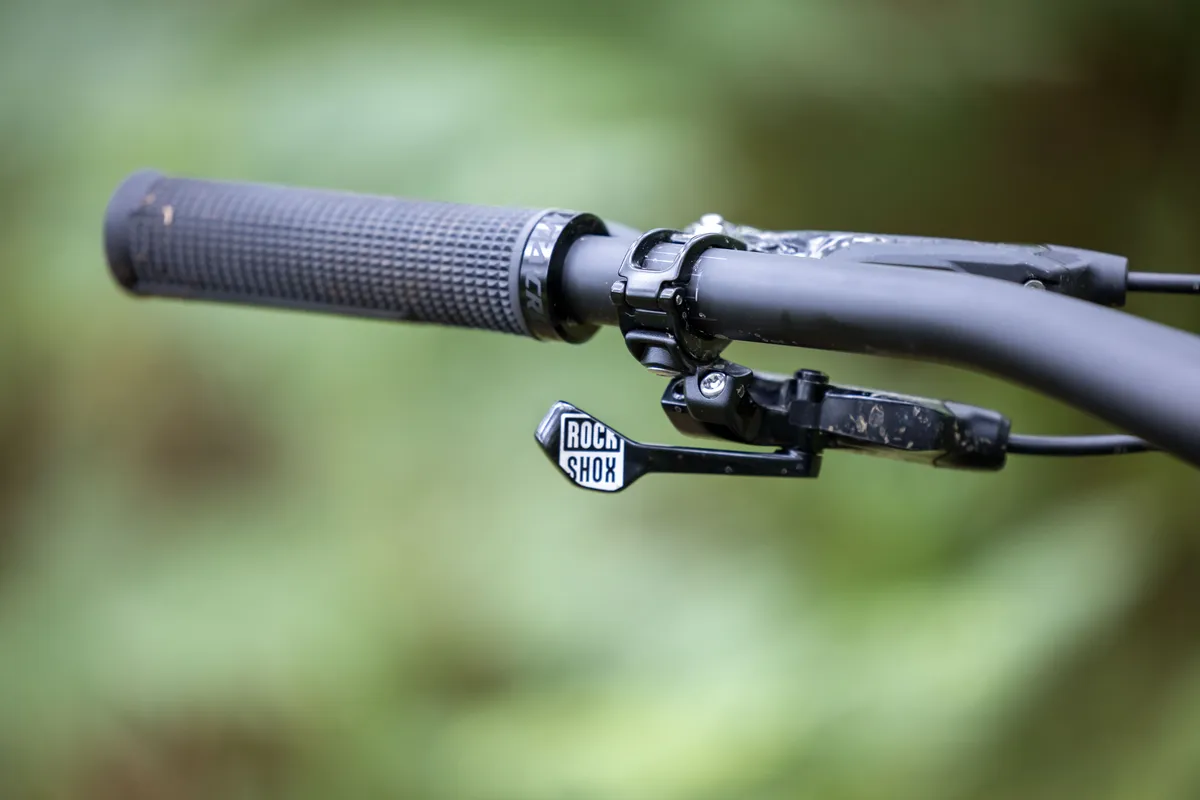
Unfortunately, no models of the Bronson are sold with RockShox' Reverb AXS dropper, so if you’re after the ultimate in electronic performance, an aftermarket upgrade might be in store.
The smaller 180mm rear disc brake rotor helped keep weight down for the climbs, but was easy to overheat on the descents, with a corresponding decrease in performance.
Unusually for an AXS-equipped bike, Santa Cruz has chosen to spec a 10-50t cassette, rather than SRAM’s widest-ranging 10-52t version. While I personally prefer the smaller step between the 42t and 50t sprocket, the two-tooth bigger sprocket would have extended the Bronson’s climbing prowess, especially considering it runs a 32t chainring.
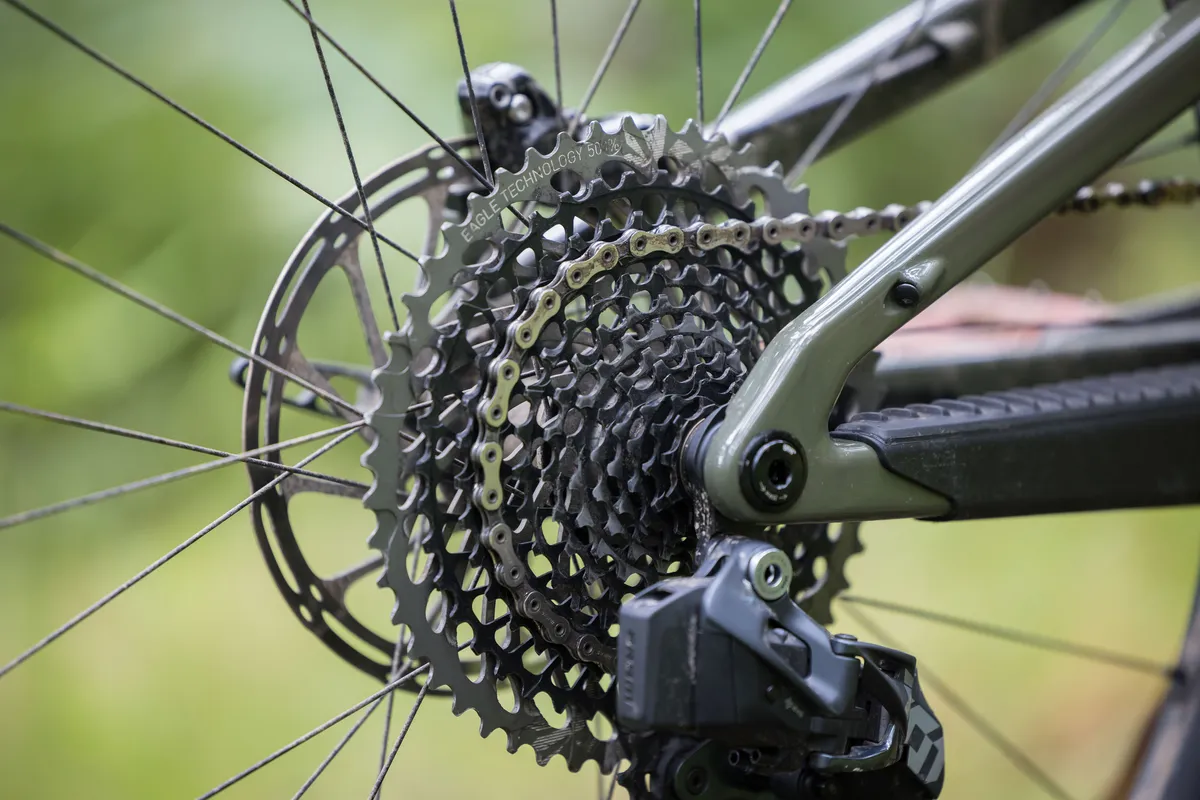
Santa Cruz told me the smaller 10-50t cassette was fitted because it found the jump between the largest and second-largest sprockets on the 10-52t too big. It also said it thinks the gearing on the Bronson should be sufficient for most people and riding spots.
Depending on your fitness levels, pedalling cadence preferences and terrain type, changing it out for a 10-52t or swapping the chainring for a 30t might be something to consider.
I did find the WTB Volt saddle to be especially uncomfortable for my body’s anatomy, and I had to remove it to test the bike – although this isn’t an issue for everyone, and some of our testers get on with WTB’s saddles. However, when purchasing a £8,599 bike, customisation options for contact points would be useful for this reason.
2022 Santa Cruz Bronson CC MX X01 AXS RSV descending performance
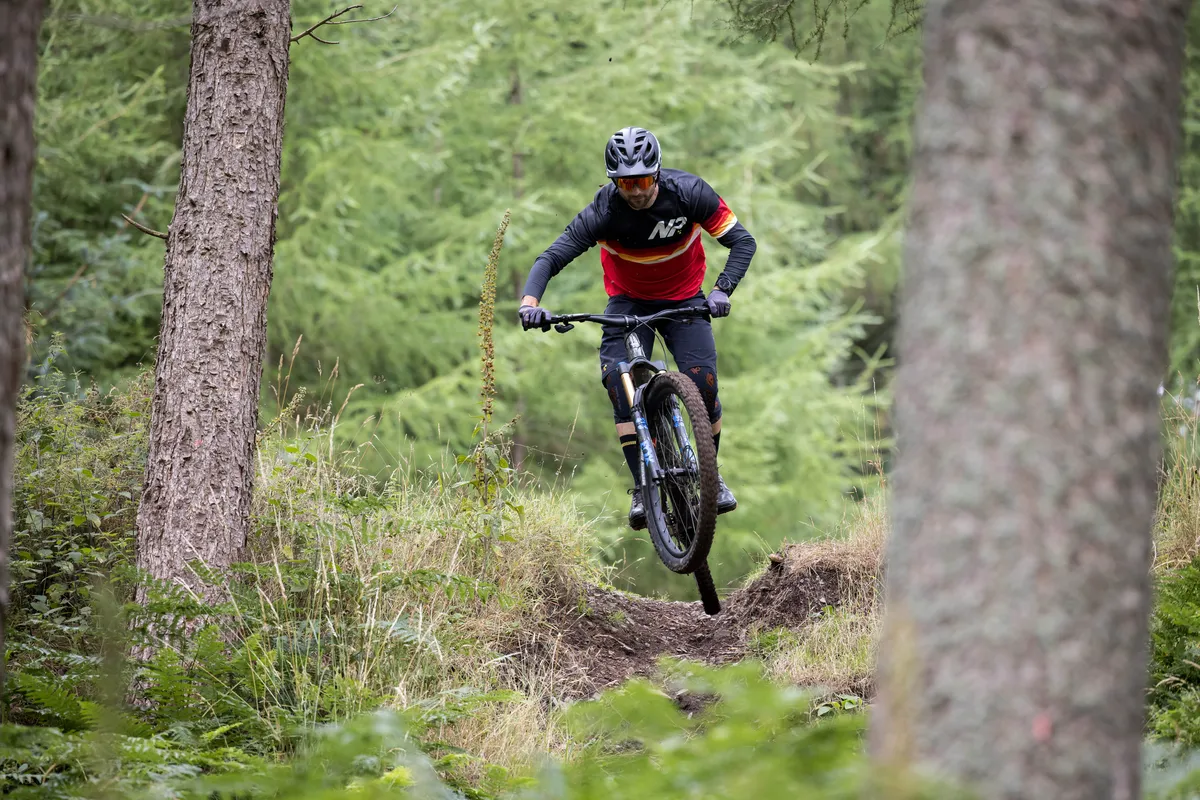
When heading downhill, and once I'd learned where and how to push it to its limits, the Bronson can be fun to ride, but isn’t a super-smooth, flat-out trail neutraliser.
Punchy suspension
The suspension’s kinematics and feel – which isn't hugely supple at the start of its travel – were a key component to creating the Bronson’s feel.
On the trail, this lack of sensitivity didn’t translate to a frenetic lack of grip or a harsh ride, but rather felt like it didn’t quite track the trail’s undulations with total precision. Instead, the rear wheel felt like it was thudding over bumps rather than jumping out of the way of them.
The back wheel did get hung up on certain bumps, especially larger square-edged rocks and roots because it was unable to absorb them.
This meant the Bronson felt like it punished its rear wheel a little more than other bikes I’ve recently tested – such as Specialized’s Stumpjumper Evo – because the rear wheel and tyre had to do more work to flatten the terrain.

This was especially evident when I rode it with straighter legs and a more aggressive style, essentially pushing the back wheel into the ground. This was something the bike encouraged and I found helped me get the most from it, but more on that shortly.
To avoid punctures and rim damage, thanks to the suspension’s kinematics and rear tyre’s EXO casing, I had to run higher than normal tyre pressures (29psi).
The eventual consequence of the rear end’s harshness and skinny rubber was a ripped rear tyre after it struck a medium-sized rock on a red-graded trail centre run. This was disappointing given the Bronson’s go-anywhere selling point, and trail centre trails should be well within its capabilities.
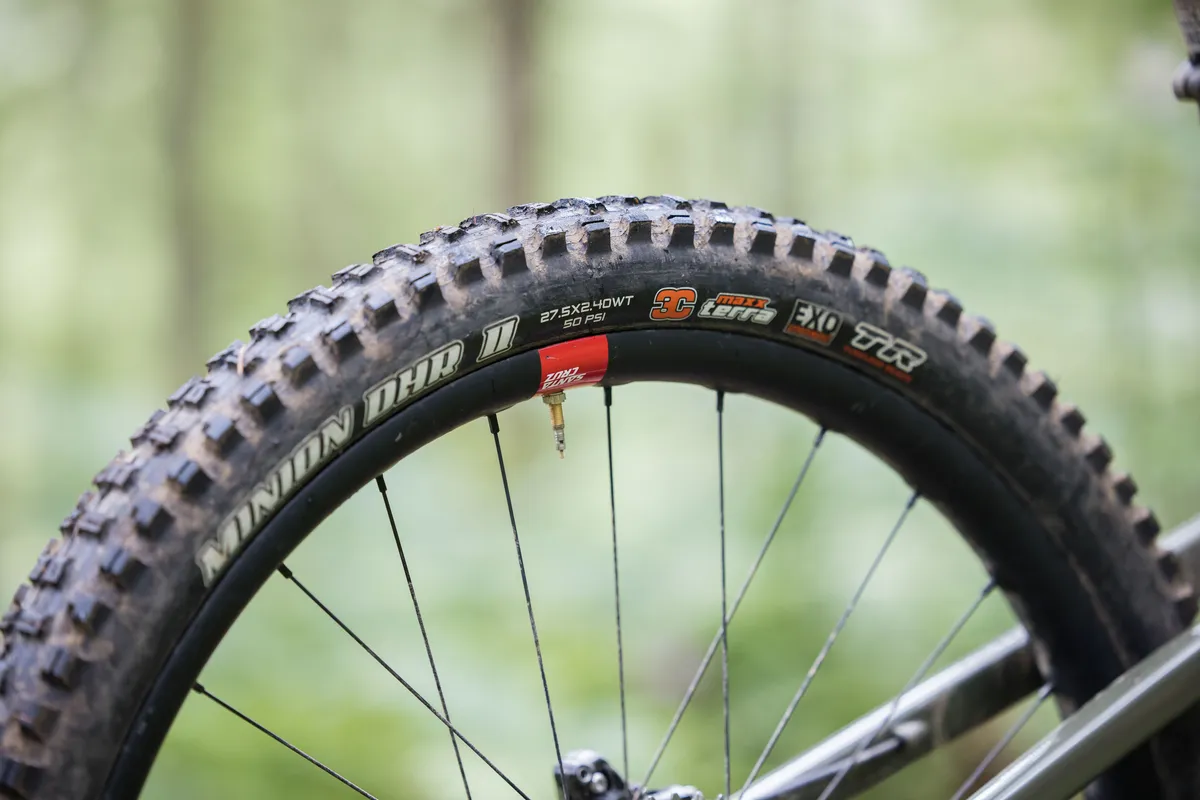
A thicker rear tyre casing would only improve the Bronson’s ride and extend its scope out on the trail.
To do just that, I fitted a Maxxis Minion DHR II DoubleDown MaxxGrip tyre to the rear of the bike, and have yet to suffer another puncture.
The tougher casing tyre and grippier rubber improved its grip and further damped the ride. Arguably, the tougher casing and softer compound rubber helped to absorb some of the smaller bumps the Bronson’s suspension couldn’t.
Limitations with clear advantages
Although the rear end can feel like it gets hung up from time to time, the payoff for this is an impressively supportive platform that’s massively capable deeper into its travel.
When speeds increase and holes deepen or get larger, the end’s progression helps create an incredibly stable platform that doesn’t get bucked or shot off-line because it has used all its travel up too easily.
The bottom-out resistance and mid-stroke support mean it feels best when ridden in a pump and push fashion, where loading the bike hard into the ground to generate grip to swap between lines feels inspired.
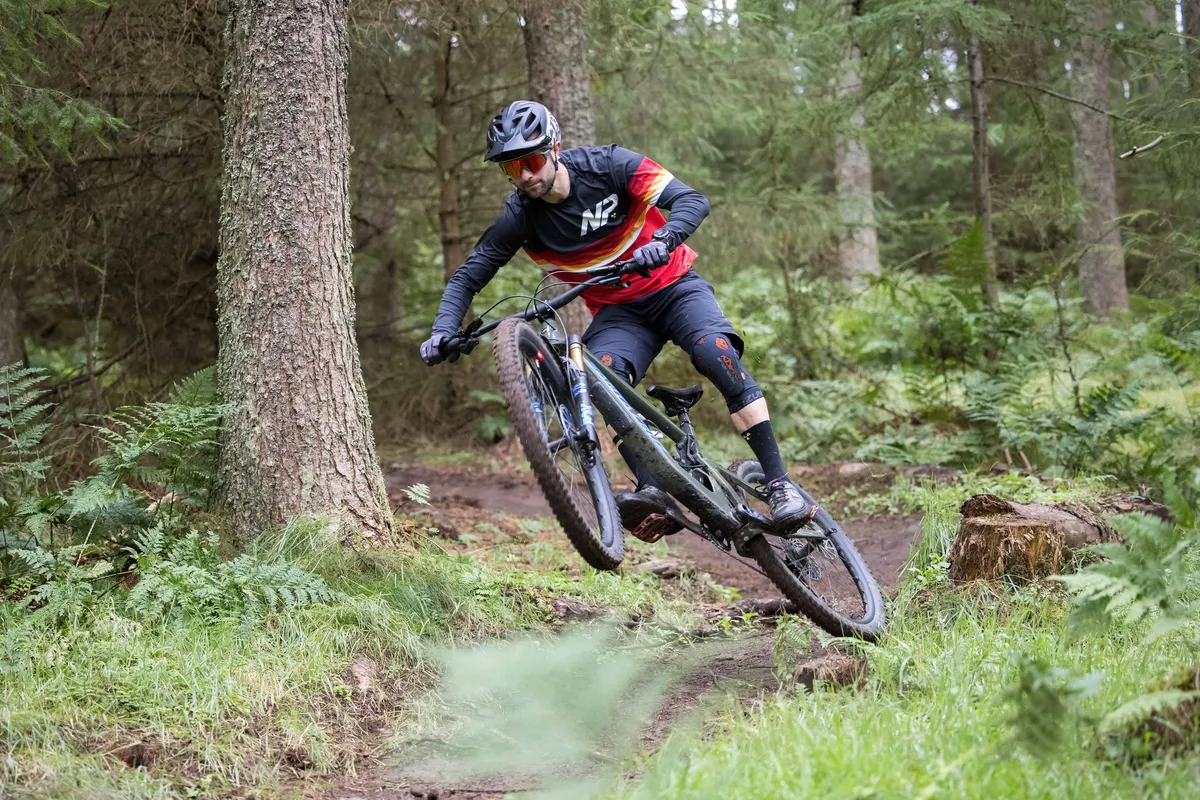
This preloading can be done over the roughest terrain with near impunity and lack of consequence.
I felt like I got the most out of the Bronson when riding in this way, driving it into the ground and focusing on maximising fun rather than outright speed.
Although this isn’t the fastest way to ride a bike, it would be accurate to describe it as hard. Fortunately, the frame, wheels and brand-new Santa Cruz carbon fibre handlebar are well suited to this punishing style in both strength and feel.
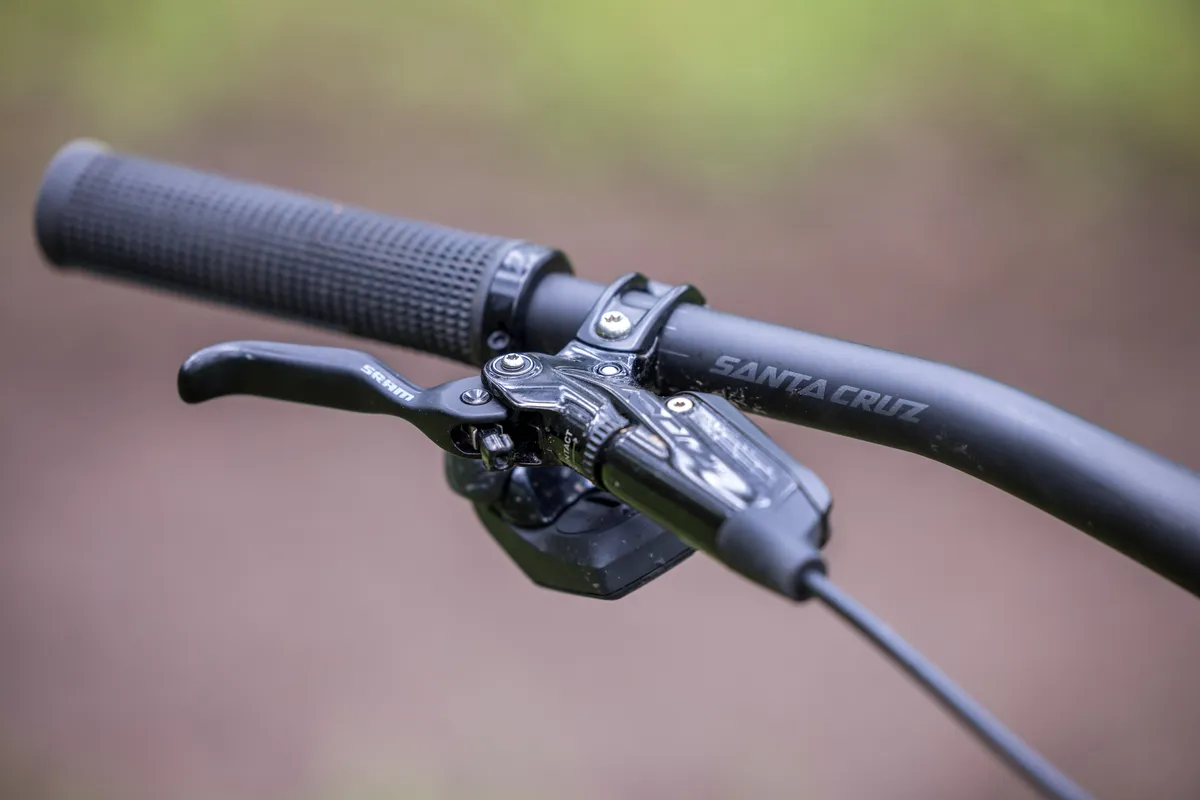
There was no detectable harshness that reverberated through the bike – despite the wide (30mm), flat profile (22mm) and carbon construction of the Reserve 30 wheels, and large box-section carbon fibre down tube – which meant it wasn’t fatiguing or uncomfortable on long descents.
In this respect, I think the Bronson could be best described as more of a bruiser than a super-snappy trail smoother.
A towering front end

True to the statement on Santa Cruz’s website, the Bronson does indeed have a rearward-feeling bias.
The other way of looking at that is the front end feels quite high, and this was something I ended up investigating during the test period because it could be a problem for some, but brilliant for others.
While the geometry chart numbers don’t necessarily stack up to indicate the front end will feel high, there was no denying how high it felt on the trails.
The size large Bronson I tested has a 637mm stack, which isn’t much higher or lower than a host of other bikes I’ve ridden in recent times: Specialized’s Turbo Levo measures 636mm, the Devinci Spartan HP has a 639mm figure, while the Pole Stamina 160 Remastered has a 645mm height, and Yeti’s SB165 is 609mm – and none of these felt especially high or low.
So why did I end up setting the stem to its lowest possible position and feel like the Bronson’s front end was just too high? The answer to that question is tricky to pin down precisely, but there’s clearly more going on here than the stack height alone.
The combination of geometry figures, including stack height, wheelbase, chainstay, reach, head tube angle and bottom bracket height – just a few millimetres here and there – are both shorter and longer compared to other bikes. This, I think, gives the Bronson its high-feeling front end.
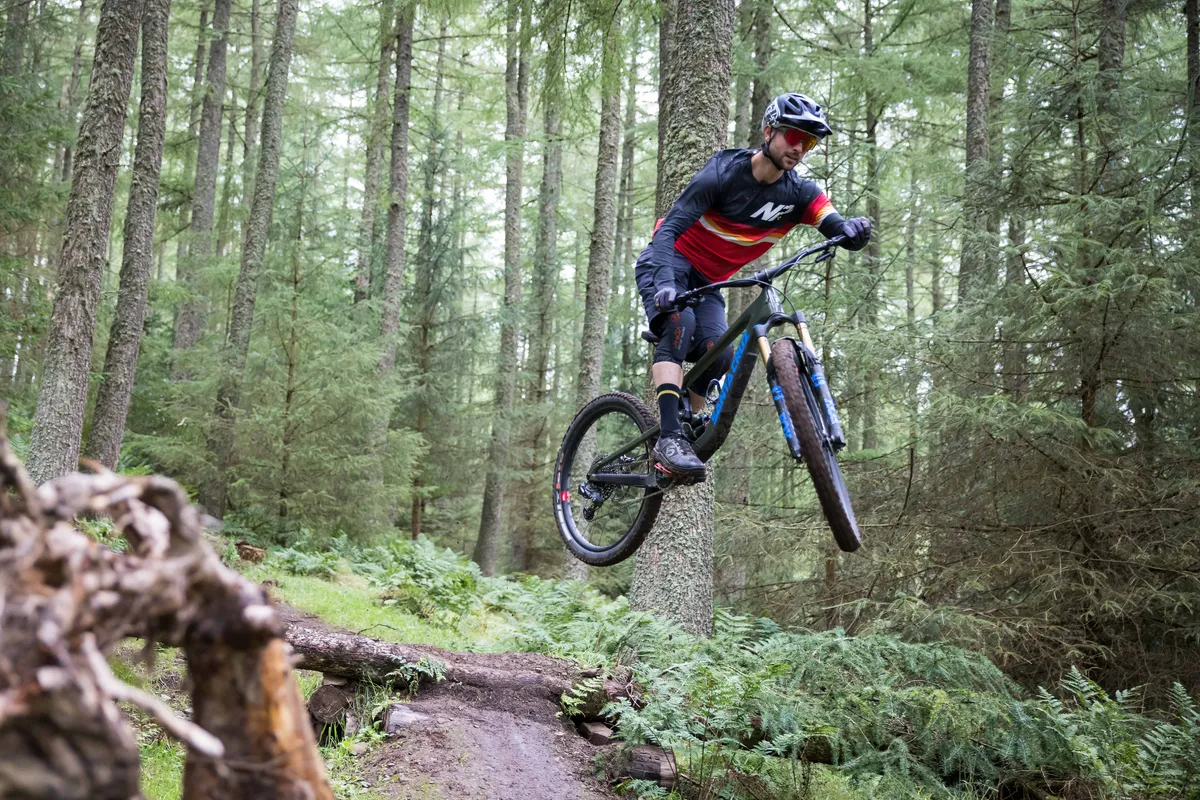
How does this make it ride? In some scenarios, it was inspired, but in others, quite frustrating.
I found in some turns, whether they were flat, bermed, sharp, open, on steep or mellow terrain, the bike just wouldn’t corner how I wanted it to.
Its wheels felt like they were carving two different radii; normally the front one running high up a turn with the rear one staying lower. At times, this made cornering an unsatisfying affair because I couldn’t make the bike hook around a turn or get the front wheel to ‘tuck’ underneath me like I wanted and expected it to.
I found I could counteract this by loading the front wheel harder and more confidently than I would usually, but this caused the rear end to go very light.
This meant cat-like reflexes and weight shifts were needed to keep the back end from losing control, although it felt great when I was able to drift it and subsequently catch it before totally losing control.
That was when the Bronson felt great to ride, and totally exhilarating, too.
Although loading the front end like this was the best way to get the Bronson to corner, I also tried reducing fork spring pressure to lower it and stiffened the rear shock to keep the rear end propped up.
These two approaches had their own problems. Making the fork softer caused more bottom-outs than I was comfortable with, and making the shock stiffer further reduced its already limited small bump compliance. And increasing fork sag steepened the head tube angle, but so did decreasing rear shock sag.

The other temptation was to decrease fork sag to help provide support against the extra weighting I was putting through the front end to corner correctly, but decreasing sag meant the front end rode higher, needing even more weight to keep it in check.
When riding at higher speeds or on technical trails, the issue was further compounded by the fairly conservative head tube angle, reach and wheelbase, at least compared to bikes like the Specialized Stumpjumper Evo with its 63-degree head angle and 1,261mm wheelbase.
The steeper head tube angle encouraged a more over-the-back riding position.
None of this helped with confidence on steep, fast or gnarly trails, or overcame the high front end.
And on those steeper trails, the head angle meant the steering had some twitchiness to it. This encouraged me to lean further back than I would usually, making it hard to pick and commit to lines without an element of hesitation that longer, slacker bikes don’t create.
So the front end produced a bit of a catch-22, where the perfect setup felt almost unattainable.
It was possible to ride around the problem by slowing down and focusing on bouncing across the trail and through tech sections or committing to riding over the front and living with the lively rear end.
What could Santa Cruz do to help resolve this?

I’m keen to not make a mountain out of a molehill, and the height of the Bronson’s front end and the way it rode will suit some riders out there – and I wouldn’t go as far to call it an ‘issue’.
Also, the Bronson’s negative traits were most apparent when riding gnarlier, steeper, more technical or faster tracks.
Once I’d backed off a bit and expected less pace from it, those traits diminished significantly, which points more to the limitations of a 150mm travel, 64.5-degree head angle bike rather than any inherent design flaws in its suspension, geometry or otherwise.
But there are still some things Santa Cruz could do to help mitigate some of the traits I experienced when testing the Bronson.
The easiest way to increase rear-end suppleness would be to give buyers the option to spec a coil-sprung shock. The rear end was progressive enough to handle a linear spring rate but would benefit from the off-the-top suppleness of a coil.
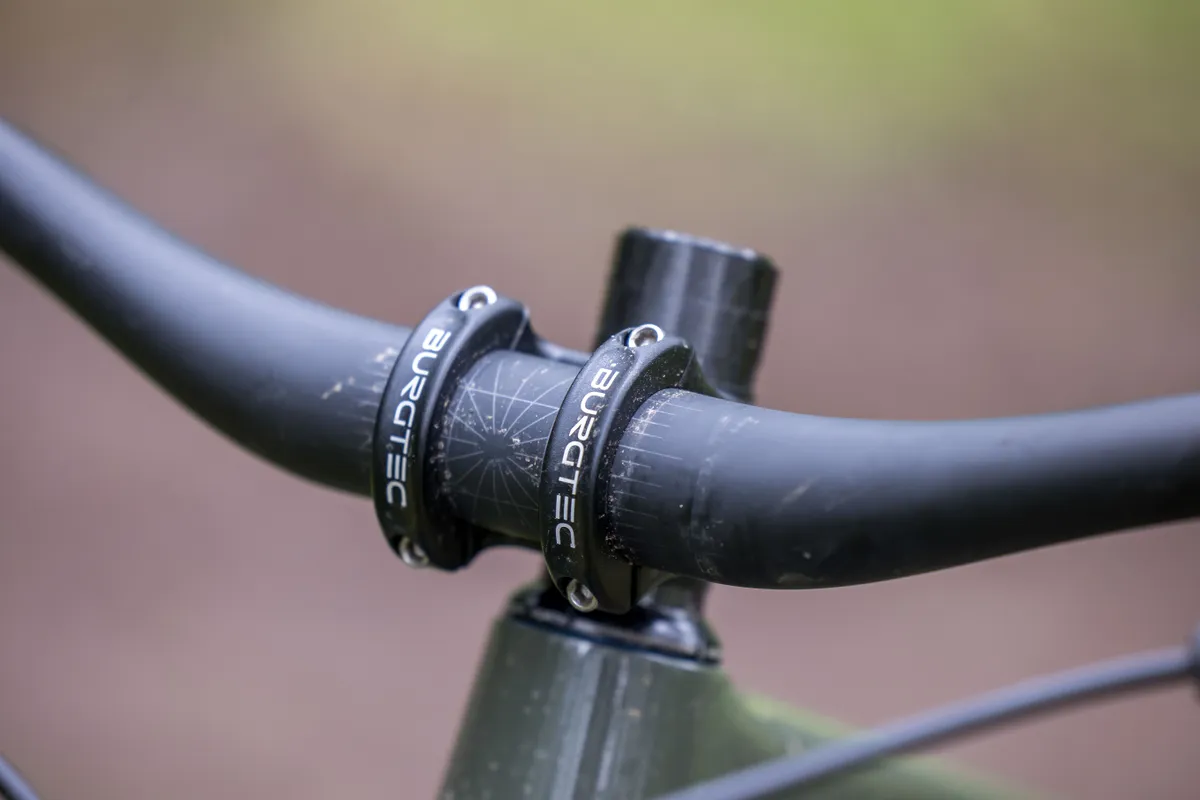
Next up, offering a lower rise bar (stock is 35mm) would be the cheapest and most effective way to reduce how high the front end feels. I found the geometry of the bar felt good, so care would need to be taken to find a similar one in a lower rise to not upset other parts of the bike’s ride quality.
However, a lower bar wouldn’t alter the bike’s stack height but would change the position of your hands in relation to your feet, maybe improving that relationship.
Lowering the stack by a couple of millimetres and increasing the reach and front centre figures, while slackening the head tube angle, should make it feel not quite as front-high, too.
However, changing the figures would bring it closer to the Nomad and that’s probably something Santa Cruz doesn't want to do from a marketing perspective. I suspect it would open up a heap of potential in the Bronson’s frame, though.
2022 Santa Cruz Bronson CC MX X01 AXS RSV bottom line
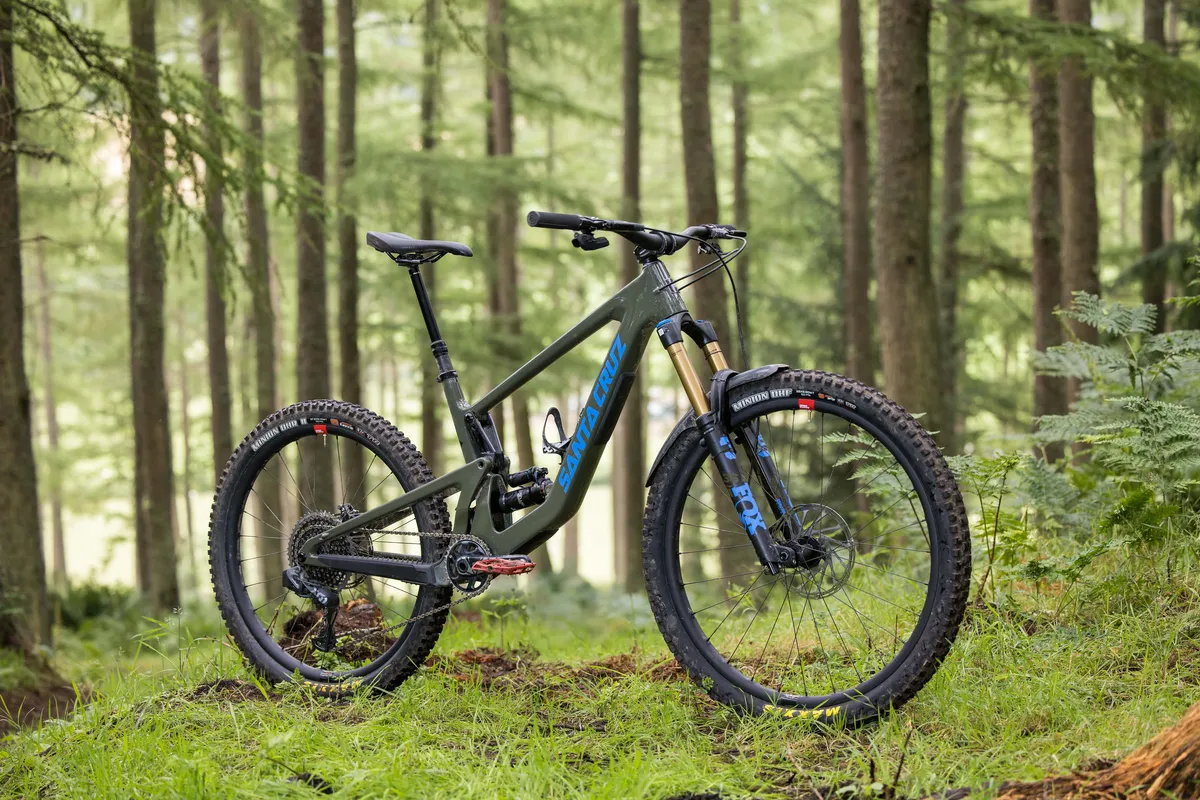
Outright racer-like speed doesn’t seem to be the Bronson’s aim (unless, of course, your name is Sam Dale, Mark Scott or Jake Ebdon – who all rode the Bronson to impressive success at the UK’s round of the 2021 Enduro World Series in the Tweed Valley in Scotland).
Instead, it seems to thrive on thrashing down well-known trails in creative, fun and confidently hard-riding ways, where its supportive mid-stroke and generous bottom-out resistance are its most dominant traits.
If you can learn how to put them to good use, the Bronson is a true pleasure to ride, just make sure you’ve got the confidence to weight the front wheel enough in the turns.
The Bronson is – just like Santa Cruz claims – a great bike for pretty much any type of riding, and I ended up using it in my free time for post-work evening blasts.
It maybe lacks the specificity of others on the market, and has some interesting quirks, but it’s really good fun to ride on most trails and is rewarding to do so once you've mastered it.
Just don’t expect it to confidently tackle terrain at the most extreme ends of the bell curve, where one of the best enduro bikes or lightweight trail bikes might be better.
Product
| Brand | santa_cruz |
| Price | 8599.00 GBP,9849.00 USD |
| br_whatWeTested | Santa Cruz Bronson CC MX X01 AXS RSV |
| Weight | 14.1500, KILOGRAM (Large) - Size large, without pedals |
Features
| Fork | Fox 36 Float Factory, GRIP2 |
| br_stem | Burgtec Enduro MK3 |
| br_chain | SRAM X01 Eagle |
| br_frame | Santa Cruz Bronson CC Carbon |
| Tyres | Maxxis Minion DHF 29x2.5in 3C MaxxGrip EXO TR (f), Maxxis Minion DHR II 27.5x2.4in 3C MaxxTerra EXO TR (r) |
| br_brakes | SRAM Code RSC |
| br_cranks | SRAM X1 Eagle |
| br_saddle | WTB Volt |
| br_wheels | Santa Cruz Reserve 30 V2 Carbon on Industry Nine hubs |
| br_headset | Cane Creek 40 |
| br_shifter | SRAM GX Eagle AXS |
| br_cassette | SRAM XG1295 10-50 12-speed |
| br_seatpost | RockShox Reverb Stealth 175mm travel |
| br_gripsTape | Santa Cruz House Grips |
| br_handlebar | Santa Cruz 35 Carbon Bar, 800mm, 35mm rise |
| br_rearShock | RockShox Super Deluxe Ultimate |
| br_bottomBracket | SRAM DUB 72mm BSA |
| br_availableSizes | Extra-small, small, medium, large, extra-large |
| br_rearDerailleur | SRAM X01 Eagle AXS |
| Features | Carbon CC, geometry adjust |
